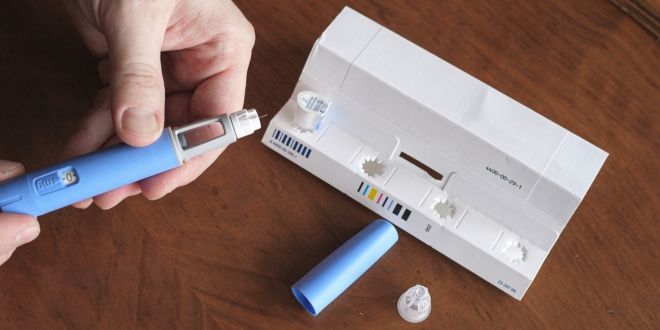There has been a rapid rise in awareness and use of GLP-1 medications like Ozempic (semaglutide), Wegovy (semaglutide), Mounjaro (tirzepatide), and Zepbound (tirzepatide). More people than ever are turning to these medications for support with weight loss, blood sugar regulation, metabolic health, and conditions like PCOS.
At the same time, many are also looking to the Whole30 as a way to identify hidden food sensitivities. Through the program, participants are able to determine the foods that work best for their bodies, create new habits, and restore a healthy relationship with food and their body.
If you’re wondering, “Can I do the Whole30 on a GLP-1,” you’re not alone. This question has been popping up more frequently in our community, for good reason. Though they work in very different ways, both tools can support improving health and nutrition.
To find out more, Melissa talks with Dr. Spencer Nadolsky from Vineyard, who is board certified in obesity medicine and lipidology, and Registered Dietitian and Certified Specialist on Obesity and Weight Management, Summer Kessel about the intersection of GLP-1 medications and the Whole30. In this article, we’ll explore how the Whole30 and GLP-1s interact, what to consider before combining the two, and how to adapt the program to meet your body’s needs while on this medication.
MU: What kind of side effects are the most common on a GLP-1?
Dr. Nadolsky: With over a decade of experience in obesity medicine, I’ve seen a wide range of patient responses to the medication. However, some side effects show up pretty consistently across the board, especially in the early weeks of treatment or after a dose increase. The most commonly reported side effects include:
- Nausea (typically mild to moderate)
- Heartburn or acid reflux
- Abdominal bloating or discomfort
- Constipation
Some of these are related to delayed gastric emptying. When on a GLP-1, food stays in your stomach longer, which promotes satiety, helps to control your appetite, and improves blood sugar control. However, this can also lead to nausea, bloating, and discomfort. These side effects are largely dose-dependent, meaning they tend to be more pronounced at higher doses or during transitions between dose levels. The good news is that most people find these symptoms improve significantly over time, as the body adjusts to the medication. We can also proactively manage many of these side effects through strategic meal adjustments, which we’ll cover in a bit.
MU: Are there other dietary concerns when on a GLP-1, besides the side effects?
Dr. Nadolsky: For sure. There are key nutritional concerns we need to monitor closely while someone is on a GLP-1. When appetite is significantly reduced, as it often is with these medications, there’s a risk that patients don’t eat enough to meet their basic nutritional needs. One of my top priorities is ensuring they’re consuming enough food to support metabolic health, energy levels, and overall well-being.
Protein intake is especially important. With reduced appetite, many people tend to under-eat protein. This can contribute to muscle loss over time, especially in the context of weight loss. I encourage patients to prioritize high-quality, lean protein sources at each meal to help preserve lean mass and support recovery, strength, and satiety.
Hydration is another area to watch. Nausea or vomiting can reduce fluid intake, and slower digestion can leave patients feeling too full to drink water regularly. I recommend spacing water between meals and being intentional about fluid intake throughout the day.
Finally, fiber plays a critical role in managing constipation, which is a common issue on GLP-1s. I encourage a mix of soluble and insoluble fiber from vegetables, fruits, nuts, seeds, and other whole-food sources to support digestion and help maintain blood sugar balance.
MU: Can you do the Whole30 while on a GLP-1?
Dr. Nadolsky: Absolutely. It’s certainly safe to do the Whole30 while you’re taking a GLP-1. Technically, someone could take the medication and just eat less of what they’re normally eating. However, I’m much more assertive in counseling patients to make dietary changes at the same time. I encourage protein, fiber, and more whole foods in general, much like you’d find on the Whole30 meal template. I don’t ask them to count macros or calories, but it does benefit people to make diet and lifestyle changes while on the medication. And in fact, being on a GLP-1 often makes these changes much easier—and could make doing an elimination program like the Whole30 easier too.
MU: What kind of advantages are there to doing the Whole30 while on a GLP-1?
Dr. Nadolsky: These medications help people do the things that they know they should do, but really struggle to do. In general, the reduction of appetite and food noise would make the program more satisfying, and the elimination phase easier to stick to.
MU: I’ve heard so much about food noise lately! What is that, exactly?
Dr. Nadolsky: Food noise isn’t a specific craving for a specific food. It describes the persistent and often overwhelming thoughts about food. It could be chips, it could be egg whites, it’s not specific to the food. Food noise makes you fixate on planning meals and what you’ll eat next. Patients often report a constant mental dialogue around food: “I just ate, but I still want more. When can I eat next? I shouldn’t eat dessert, but can I just have a small piece?” You’re always thinking about food. It’s incredibly distracting, takes up a ton of emotional energy, and often leaves you feeling guilty and anxious.
Read our in-depth research on food noise.
MU: Got it. So less food noise could make it easier to stick to a program like Whole30!
Dr. Nadolsky: Exactly. Because you’re no longer anxious or hyper-fixated on food, you may feel like you can actually do a program like the Whole30. For example, on the Whole30, people might think, “I know I should be eating protein and vegetables, but I’m craving chips. All I can think about are chips.” On a GLP-1, it’s like, “No, I don’t need to have the chips. I can eat these other foods, and they actually taste good to me.”
While on a GLP-1, you’ll probably find it much easier to avoid bread, baked goods, chocolate, and alcohol than you would have before the medication. And the structure of the Whole30 meal template already provides for adequate protein, fiber, and micronutrient intake, although I would recommend some variations.
Using the Whole30 to identify the foods that work best for you and hidden triggers for inflammation and other symptoms could help you further dial in your diet while on a GLP-1. And if patients ever step down their dose or come off the medication, the learnings they discover through their Whole30 elimination and reintroduction could certainly help them maintain those weight loss and health benefits.
MU: For those on a GLP-1, what changes would you make to the Whole30 meal template?
Summer: The majority of folks on GLP-1s don’t need a special diet above and beyond a well-balanced, high-protein plan that prioritizes whole foods. What matters the most is their eating pattern. I generally recommend:
- Eating at least three times a day
- Eating enough protein and carbs spread throughout the day
- Eating complete meals that include fruits and vegetables
- Not snacking too often (and if you do, managing portion sizes)
In the case of side effects, we may also encourage a lower fat or even lower fiber approach, depending on tolerance. Those on a GLP-1 struggle with high-fat meals, as fat itself is slower to digest and can trigger nausea. Choosing lean proteins and practicing portion control around healthy fats like avocado, nuts, and oils is key.
Outside of the context of a Whole30, we may encourage the addition of simple carbohydrates like rice, pasta, and breads (if they work well for you) to improve fatigue and tolerance. In addition, if patients are struggling with low appetite, we steer them away from high-volume, low calorie foods (like big green salads) and towards foods that are more calorie-dense, like lean proteins, starchy carbs, and cooked vegetables. This will help them eat enough to sustain activity levels and energy, even with a diminished appetite.
You may also find that because you have fewer cravings around trigger foods, occasional treats can be enjoyed and satisfying in much smaller portions than before. After your Whole30 elimination and reintroduction, strict elimination of “sweets and treats” may not be necessary!
MU: Are there any supplements you recommend for those on a GLP-1?
Summer: This is highly variable, based on the person, their diet, their experience on the GLP-1, and their activity levels. There are no required supplements for everyone. I will sometimes recommend fiber supplements, magnesium citrate, or a gentle laxative to help with constipation. If you’re having a hard time eating enough protein, a protein shake could provide additional nourishment in an easy-to-digest package. I might also recommend an electrolyte supplement, especially if the person is struggling with fatigue.
MU: Is there anything you’d like to add?
Dr. Nadolsky: It’s important to remember that the goal of GLP-1 medications is not to eat as little as possible or completely eliminate hunger. In fact, some folks may still be able to eat large meals and may never have any side effects. A well planned, healthy nutrition strategy and fitness routine is still very important! Whole30 offers great general guidelines to eating whole foods-based meals that can help those on GLP-1s meet their protein, fiber, and energy needs to feel their best!
Summer: For personalized support, a registered dietitian can be a valuable part of your team. At Vineyard, we offer comprehensive care and support to navigate this journey. Learn more about the care we provide.
A word from Whole30:
The answer to “Can I do the Whole30 on a GLP-1?” is clearly a resounding yes! Dr. Nadolsky and Summer agree that GLP-1 medications and the Whole30 can complement each other, especially when used with care and awareness. While the medication reduces appetite and food noise, the Whole30 provides structure, education, and insight. Your elimination and reintroduction findings will inform your food choices for a lifetime, and ensure you have a good foundation for continuing your new healthy habits. For those who have long relied on food for comfort or stress relief, the sudden absence of food noise can feel incredibly freeing. The Whole30 offers the perfect opportunity to create new, more supportive coping tools alongside your dietary shifts.
Note:
You may find your appetite much diminished on a GLP-1. That, combined with the restrictive nature of the Whole30’s elimination phase, may make it extra-challenging to eat enough to sustain your energy, activity, and health. If this is your context, it’s important to prioritize protein, nutrient-dense and calorie-dense vegetables and fruit, and moderate amounts of healthy fats. Eat whenever you are hungry, and do not limit calories, meals, meal timing, or portions. We also advise you to follow the recommendations of your healthcare provider, and modify the program as they direct. Should you discover the elimination phase does not offer enough variety for you to maintain adequate calorie intake, please immediately discontinue the program and speak with your healthcare provider.
The opinions and/or information presented here are in no way intended as medical advice or as a substitute for medical treatment. Nothing herein is intended to diagnose, treat, cure or prevent any disease. This information should only be used in conjunction with the guidance, care, and approval of your physician. Consult your physician before beginning any diet, nutrition, or wellness plan.
















